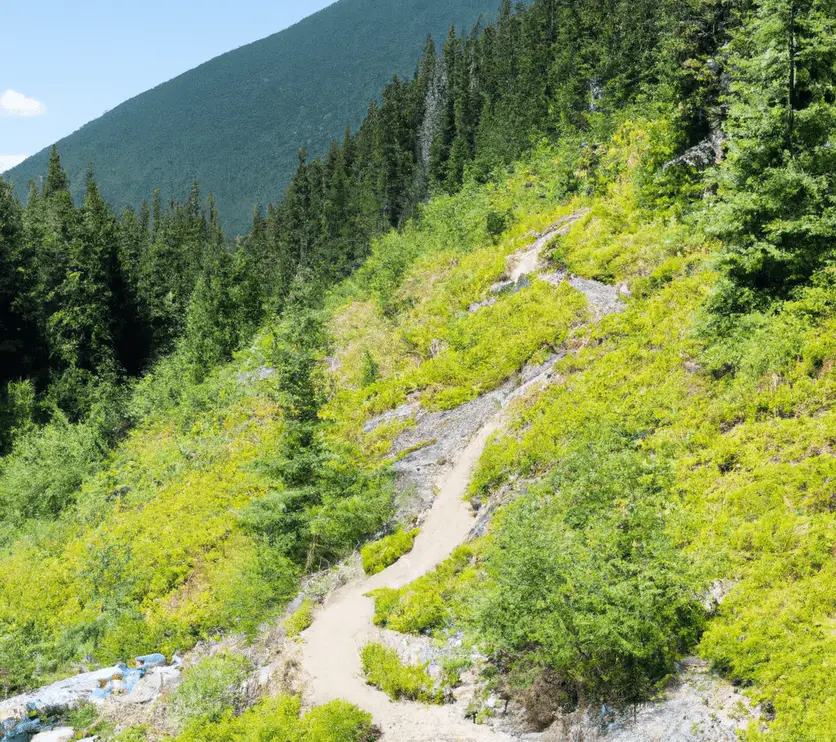What Is A Switchback in Hiking? (Explained)

You’re out for a hike on a beautiful day. The sun is shining, the birds are singing, and you’ve made it to the top of your hike. Suddenly, the trail takes a sharp turn upwards, and you find yourself staring at a seemingly endless series of switchbacks. If you’re not familiar with the term, a switchback is a method of constructing a trail that allows hikers to gain (or descend) elevation quickly without making the ascent too steep. In this article, we’ll explain what switchbacks are and how to hike them effectively.
Quick Links
What Is A Switchback?
A switchback trail or hairpin bend, as they are sometimes referred to, is a trail that cuts sharply from one direction to another while on the ascent or descent of a mountain. Switchback trails are found most frequently on the more steep sections of a mountain trail. It is very common to see multiple switchbacks in succession of each other.
What Is the Purpose of A Switchback?
Switchbacks are often used on mountain trails in order to make the ascent more gradual and, therefore, less strenuous for hikers. By zigzagging back and forth up the mountain, instead of going straight up, hikers can avoid sudden changes in elevation that might otherwise be too much to handle. Additionally, switchbacks help prevent erosion by spreading the impact of hikers’ footsteps over a larger area.
Are Switchbacks Hard?
Some hikers, both novices and experienced, may become intimidated just by the sight of a switchback, which can send them into a nervous sweat. Whether you’re ascending towards the summit or descending back to your base camp, it is normal to feel a bit nervous while hiking on these tight trails.
While not all switchbacks are on the side of a steep mountain, plenty of switchback trails come with a view of a steep drop-off. If you ever find yourself hiking along one of these more intense switchbacks, just keep in mind that this trail has probably been hiked hundreds, if not thousands of times. To further curb switchback anxiety, a trekking pole will always be useful to bring along with you.
Trekking on a switchback uphill will always be significantly easier than charging straight up and over the hill. However, just because switchback trails were designed to make hikes up steep mountains less intense, that doesn’t mean that the trails are easy, per se. One downside to taking a switchback trail is that it can add a significant amount of time to your hike. Even though this may seem tedious, taking a switchback trail will often be the best thing for your safety. As any hiker should know, hiking up and over steep mountains is never a walk in the park.
Switchbacks are the safest option when hiking over icy trails. Even with hiking boot accessories such as crampons, if your hiking trail offers the option to hike a switchback rather than having to face the mountain head-on, the switchback will always be the safer option.
History of Switchbacks
A myriad of ancient cultures built switchbacks with the clear understanding that they made for a much safer and more effective method of traveling around mountain ranges.
Many civilizations around the globe originally created switchbacks to transport pack animals carrying heavy loads. Switchback trails made scaling up and down uneven mountain terrain less challenging and safer for both humans and animals.
While it’s clear that many ancient civilizations used switchback trails to travel around their mountain ranges, it isn’t so clear as to which civilization was the first to use this technique. It is clear, however, that by the 1900s, American mining companies had perfected the switchback technique. In addition to using this technique for mining, American companies went on to use the technique to create their railway system and even some of the earliest roller coasters!
Civilizations of South America used switchbacks lined with stone to transport llamas between cities. Many of the original switchbacks the Incan Empire built are still in use today at sites such as Machu Picchu.
In the Middle East, a network of switchbacks was used to create what is now known today as King’s Highway. This trail is one of the oldest routes in the world that connected ancient Africa and Mesopotamia. The network of switchbacks is still actively traveled to this day.
In South Africa, the Sani Pass, a switchback trail that is over 100 years old at one time, only permitted foot traffic. After 1948, this switchback trail began to accommodate foot, vehicle, and animal travelers, stretching from south Africa to Lesotho.
Some switchbacks can occur naturally without human intervention. Most of the time, when this happens, it will be animals that take residence in mountain ranges, such as llamas, sheep, or mountain goats. With their help, these naturally occurring switchbacks are stomped out for animals and humans to travel on.
Navigating Switchback Trails
When traversing through trails with switchbacks, making them out on a map may at times appear quite misleading. When switchbacks are represented on a map, they can often show up as hard zigzagging lines. Contrary to their topographical representation, they are often not as dramatically angled from a 3-dimensional perspective.
Most switchbacks are soft sloping and soft-angled in nature. However, their zigzagging nature can still be observed in person.
Can you Cut Switchbacks?
Sometimes it may be tempting to cut switchbacks and take on the challenge of going straight up the mountain yourself. Despite any confidence or grand hiking experience you have, you should always follow the rules of the trail. These established trails are made not only to keep you and your equipment safe, but they are also often used to help preserve the surrounding wildlife. Switchback trails help to control soil erosion as well as landslides.
When humans trek up mountainsides, the footpaths they leave can often create gullies, a deep channel of land made worse by rain. These gullies have the potential to be devastating to an already established trail as well as to surrounding wildlife. So if signs on your hiking area insist you stick to the established trail, please practice good trail etiquette and comply to keep the environment peaceful and undisturbed.
Advice for Taking on Switchbacks
Use your hiking poles
A switchback can be rather intimidating terrain to traverse. Sometimes you may find yourself hiking a switchback with a 300-foot drop off the side of a steep mountain. To keep yourself sturdy and confident taking on these challenging switchbacks, consider taking a pair of handy trekking poles.
Make sure you have the right footwear
Just like with any other hike, making sure you have the appropriate footwear is essential in making sure you are as comfortable and safe as possible when hiking. Switchbacks can sometimes become quite steep, so you want to make sure that you have the proper footwear with the proper grip on the soles to ensure you don’t take a tumble and slip off the side of a mountain.
Allow any other hikers to pass by
Switchbacks can sometimes be very narrow, so be courteous to your fellow hikers and allow them to pass by safely. DO NOT squeeze by them. Squeezing by hikers on a switchback is not only annoying and anxiety-inducing but is also potentially life-threatening.
Take plenty of water and snacks with you
Hiking up a mountain will take a lot of energy out of you. To make sure your body has all the necessary fuel to carry you to the end of your hike, be sure to carry plenty of water as well as some of your favorite fuel-filled snacks. This will help you see your hike through to the end.
Start Early
To prevent the likelihood of coming across any heavy traffic, try to start your hike as early as possible, preferably before the afternoon. Beginning your hike earlier will also give you time to check out the weather for the day to see if any adjustments in gear or wardrobe need to happen.
Take your time
Hiking up a mountain should never be treated like a race. It can be quite an arduous mission to climb up a mountain, so allow yourself some slack and go at your own pace. The summit of the mountain isn’t going anywhere. Switchback trails can sometimes be physically strenuous to climb, as they can become just as steep as the mountainside you’re scaling.
Conclusion
Switchbacks can seem daunting at first, but with a little patience and practice, they’ll soon become second nature. Just remember to stay on the trail, pace yourself, and be aware of other hikers, and you’ll be cruising up those switchbacks in no time!







